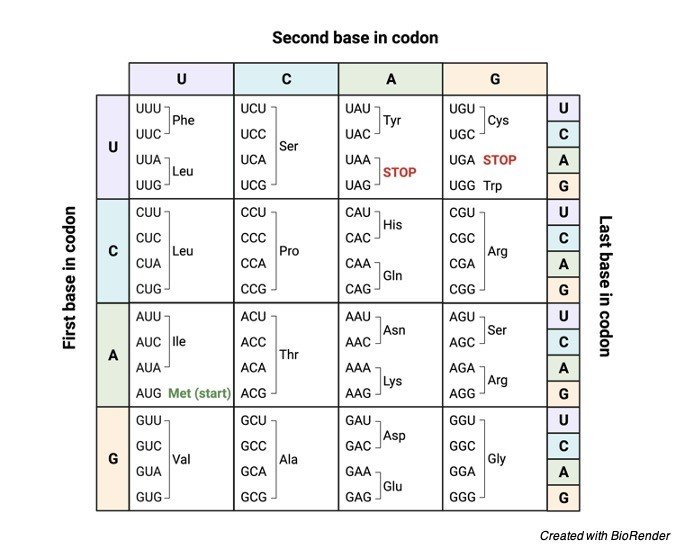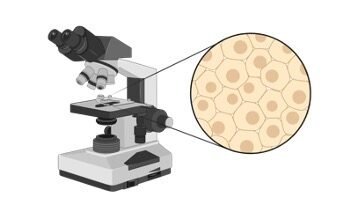What is Genetic Code?
Genetic code is one of the set of rules which is used by all the cell in the living organisms to translate the information which is encoded within the genetic material as DNA or mRNA which is the sequences of the nucleotides triplet or codons which make up the proteins.
This translation is accomplished by the cell organelle named as ribosomes, which connects the proteinogenic amino acids in order that is specified by the mRNA, with the help of transfer RNA which carries the amino acids and make it to read by the mRNA three nucleotides at the specific time.
The genetic code is similar to all organism and it is expressed within the cells in a simple way.
This codon specifies the amino acid which will be added to the next during protein synthesis. However, with some of the expectations, three nucleotide codons in a nucleic acid sequence specifies a particular amino acid.
Majority of the genes are encoded with the appropriate way according to its function. The observation of how proteins are encoded begins after the discovery of structure in year 1953.
George Gamow postulated the three bases which are needed to encode the 20 amino acids which are used by the living cells that are used to build up the proteins. It allows a maximum of 64 amino acids.
Features of Genetic Code
Genetic code is defined as the sequence of nucleotides present in the nucleic acids such as DNA (Deoxyribonucleic acids) or the RNA (Ribonucleic acids) which determines the amino acid sequence of the proteins.
Even the linear sequence of nucleotides in the DNA contains the information for the protein sequences, where proteins are not made directly from the DNA, rather the linear sequence of the nucleotides in the DNA contains specific information for the protein sequences, Proteins are not synthesized directly from the DNA and which directs the formation of the protein.

Genetic Code Chart
RNA is also composed of four nucleotides namely adenine, guanine, Cytosine and Uracil. Where as the three adjacent nucleotides constitute a unit known as the codon, which codes for the amino acid.
For example: the sequence of the codon AUG which specifies the methionine amino acid.
There are almost 64 possible codons, out of which three does not code for amino acids, but these indicates the end of the protein.
The remaining 61 codons specifies the 20 amino acids which make up the proteins the codon AUG additionally indicates the start of the protein along with the coding of the methionine.
Methionine and tryptophan are considered as the two amino acids which are coded by just a single codons AUG and UGG respectively.
The remaining 18 amino acids are coded by the two to six codons. The amino acids are coded by more than a single codon and it is called as a codon-degenerate.
The genetic code once thought to be identical in all forms of life, which has been found diversely in certain organisms and also in mitochondria in some eukaryotes.
Types of Genetic Code
The genetic code is differentiated into two types and they can be expressed in the form of either RNA codons which occur in the messenger RNA and the codons reads the information during the production of polypeptides during the process of translation.
Each of the messenger RNA molecules acquires their sequence of nucleotides by the process of transcription from the corresponding DNA.
Because during the process, DNA sequencing becomes rapid because most of the genes are now being discovered during the level of DNA before they are discovered as mRNA or as a product of protein, which is extremely useful to have the table of codons which is expressed as DNA.
DNA Codons
These codons are read on the sense strand of the DNA. Except the nucleotide Thymine(T) which is found in the place of Uracil, which reads the same as RNA codons. mRNA is synthesized with the help of antisense strand of the DNA which acts as a template.
Types of Codon
The genetic code has about 64 triplets of nucleotides. The triplets are known as codons, with the three expectations, each of the codon encodes for one of the 20 amino acids for the production of proteins.
This produces some of the redundancy in code. Almost all the amino acids are encoded more than a single codon.
Where one codon is AUG which serves the two related functions. It also signals for the start of translation, and its codes for the incorporating of the amino acid methionine into the growing chain of the polypeptide chain.
The codons are of two types namely;
Sense codons
Signal codons
I. Sense Codon
Sense codons codes for the amino acids. There are about sixty-one sense codons in the genetic code, which has to be code for 20 amino acids.
II. Signal Codon
Sense codon codes for the signaling during the production of proteins. There are about four codons that codes for a signal, namely AUG, UAA, UAG and UGA. Signal codons are further classified as two types namely
Start codons: The codon which starts the process of translation is known as start codon. It is also commonly called as initiation codons as it initiates the production of polypeptide chain. The best said example for start codon is AUG. This codes for the amino acid methionine, in prokaryotes it is N-formyl methionine.
Stop codons: Stop codon provides a signal for termination of a polypeptide chain. These codons are commonly called as termination codons as they provide a signal for the termination and the release of the polypeptide chain.
Properties of Genetic Code
Genetic code-Triplet: It consists of 64 codons, which are sufficient to code the 20 amnio acids and it helps in signaling the start and stop codons and synthesizing the polypeptide chain. Where as a in a triplet code 3 bases of RNA codes for a single amino acid.
The code is also universal which are assigned for the same amino acids.
The genetic code is comma less where the codons are continuous and are demarcation lines between the codons.
The genetic code is usually non-over lapping. Whereas in non-overlapping two amino acids are being coded by the six bases.
The genetic code is also non-ambiguous, Redundant and it has a polarity.
Genetic Code Citations
- The evolution of the genetic code: Impasses and challenges. Biosystems . 2018 Feb;164:217-225.
- The Cipher of the Genetic Code. Biosystems . 2018 Sep;171:31-47.
- Origin and Evolution of the Universal Genetic Code. Annu Rev Genet . 2017 Nov 27;51:45-62.
- The path to the genetic code. Biochim Biophys Acta Gen Subj . 2017 Nov;1861(11 Pt A):2674-2679.
- Understanding the Genetic Code. J Bacteriol . 2019 Jul 10;201(15):e00091-19.
- Rewriting the Genetic Code. Annu Rev Microbiol . 2017 Sep 8;71:557-577.
Share




















